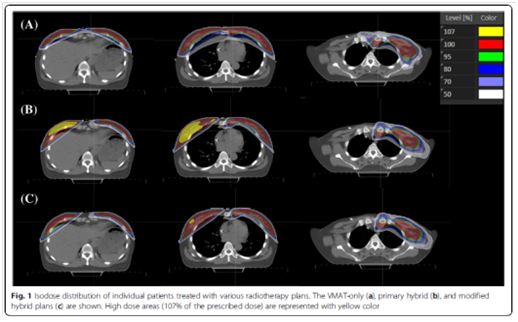글로벌 연구동향
방사선종양학
- [Radiat Oncol.] Evaluation of optimal treatment planning for radiotherapy of synchronous bilateral breast cancer including regional lymph node irradiation.
연세의대 / 조연아, 이익재*
- 출처
- Radiat Oncol.
- 등재일
- 2019 Apr 1
- 저널이슈번호
- 14(1):56. doi: 10.1186/s13014-019-1257-5.
- 내용

Abstract
BACKGROUND:
We evaluated the optimal radiotherapy (RT) plan for synchronous bilateral breast cancer (SBBC), especially treatment plans including the regional lymph node (LN) area.METHODS:
This study was conducted using 15 patients with SBBC (5 with small breasts, 5 with large breasts, and 5 who underwent a left total mastectomy). The clinical target volume (CTV) was defined as the volume enveloping the bilateral whole breasts/chest wall and left regional LN area. We established the following plans: 1) volumetric-modulated arc therapy (VMAT)-the only plan using two pairs of partial arcs for the whole target volume, 2) VMAT using one partial arc for the left CTV followed by a 3D tangential technique for the right breast (primary hybrid plan), and 3) VMAT for the left CTV followed by a tangential technique using an automatically calculated prescription dose for the right breast, considering the background dose from the left breast VMAT plan (modified hybrid plan). The Tukey test and one-way analysis of variance were used to compare the target coverage and doses to organs at risk (OARs) of the three techniques.RESULTS:
For target coverage, the VMAT-only and modified hybrid plans showed comparable target coverage in terms of Dmean (50.33 Gy vs. 50.53 Gy, p = 0.106). The primary hybrid plan showed the largest distribution of the high-dose volume, with V105% of 25.69% and V110% of 6.37% for the planning target volume (PTV) (p < 0.001). For OARs including the lungs, heart, and left anterior descending artery, the percentages of volume at various doses (V5Gy, V10Gy, V20Gy, V30Gy) and Dmean were significantly lower in both the primary and modified hybrid plans compared to those of the VMAT-only plan. These results were consistent in subgroup analyses of breast size and morphological variation.CONCLUSIONS:
The modified hybrid plan, using an automatically calculated prescription dose for the right breast and taking into consideration the background dose from the left breast VMAT plan, showed comparable target coverage to that of the VMAT-only plan, and was superior for saving OARs. However, considering that VMAT can be adjusted according to the physician's intention, further evaluation is needed for developing a better plan.
Author informationCho Y1, Cho YJ1, Chang WS1, Kim JW1, Choi WH1, Lee IJ2.
1
Department of Radiation Oncology, Gangnam Severance Hospital, Yonsei University College of Medicine, 211 Eonju-ro, Gangnam-gu, Seoul, 06273, Korea.
2
Department of Radiation Oncology, Gangnam Severance Hospital, Yonsei University College of Medicine, 211 Eonju-ro, Gangnam-gu, Seoul, 06273, Korea. ikjae412@yuhs.ac.
- 키워드
- Breast Cancer; Organs at risk; Radiotherapy dosage; Volumetric-modulated arc therapy
- 덧글달기
- 이전글 [Radiother Oncol.] Dose escalation by intensity modulated radiotherapy in liver-directed concurrent chemoradiotherapy for locally advanced BCLC stage C hepatocellular carcinoma.
- 다음글 [J Breast Cancer.] Central Nervous System Failure in Korean Breast Cancer Patients with HER2-Enriched Subtype: Korean Radiation Oncology Group 16-15 Multicenter Retrospective Study.










편집위원
내유림프절을 포함하여 치료해야 하는 양측성 유방암에 대해 planning study를 통해 해결방안을 제시하고 있음
2019-05-28 17:29:08